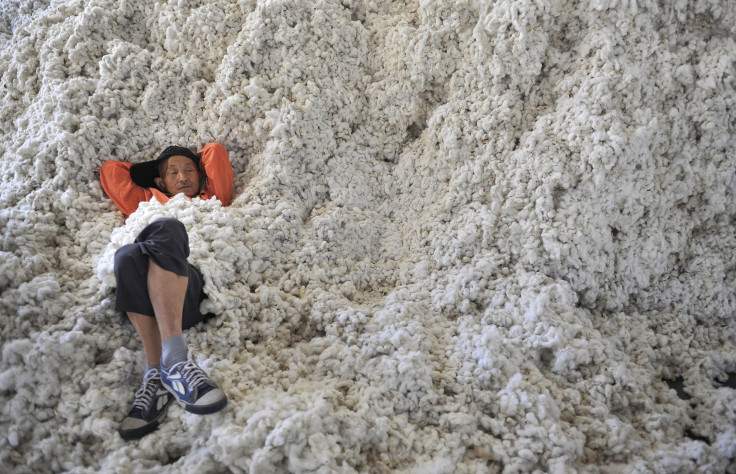There Are Lots Of Reasons To Expect Cotton Prices To Drop, But None Seem Convincing, At Least Yet
Column

China’s Third Plenum concluded last month with Beijing’s leaders vowing to ease up on state control of the world’s second-biggest economy -- and to give supply and demand greater influence over commodity prices.
Which begs the question: Whither cotton prices? Nearly 60 percent of the world’s cotton supply is stored in China, according to the U.S. Department of Agriculture. If China starts selling off that massive stockpile, prices could implode.
That could have a big impact on the United States, which is both the world’s third-largest cotton producer and its No. 1 cotton exporter. The U.S. shipped an estimated 13 million bales of cotton overseas in 2013, up from 11.7 million bales in the previous year. Most of the world’s cotton is produced in China, about 32 million bales this year, while India, the world’s second-largest cotton producer, harvested about 20 million bales. But most of the Chinese and Indian production is used domestically.
The American cotton industry generates about $27 billion in revenue and employs some 200,000 people, according to the National Cotton Council, which also notes that the cotton industry’s “total economic activity is estimated at some $100 billion.” Clearly, a drop in the price of cotton would hit U.S. cotton producers hard while cutting costs for American textile manufacturers.
China has had a policy of stockpiling strategic materials for decades, but it began an intense buildup of cotton two years ago. The policy was pursued in three ways: setting an artificially high floor price -- as much as 80 percent above the world price -- on cotton grown domestically to encourage production; forcing domestic mills to pay a tariff of as much as 40 percent on imported cotton; and boosting imports by the government’s China National Cotton Reserve Corp. China’s government is believed to have imported about 7.5 million bales in 2013, up from about 5 million in 2011. The upshot is that today China has about 18 months’ supply of the commodity on hand, according to the U.S. Agriculture Department. That’s about half of total world supply.
When China’s top government officials announced plans to let markets rise or fall more organically than in the past, cotton was among the commodities that some analysts immediately surmised would be most affected by the new policy. For example, experts at Deutsche Bank took the view that China would not only free up its excess cotton but would also begin to pay farmers directly for the crop, or offer growers insurance incentives, all of which would send cotton prices tumbling.
"The possibility that the Chinese government will move away from stockpiling and towards direct farm subsidies will discourage agricultural imports,” Deutsche Bank wrote. “This raises the possibility that agricultural prices have further downside heading into next year."
For the moment, at least, this pessimism appears to be unwarranted. On Nov. 12, when the Third Plenum ended, cotton futures on the Nymex closed at 78.22 cents per pound. For the next 10 days the price eased to 77.23 cents. After that, prices began edging higher, but -- in a slow, measured way -- by Dec. 20, cotton was selling on the Nymex for slightly more than 83 cents per pound, about what it was selling for in February.
This could change and Deutsche Bank could turn out to be right, but our guess is that cotton prices will be relatively stable going forward. Here are four reasons why:
1) China National Cotton Reserves Corp., which manages the nation’s cotton supply, began trimming imports well before the government’s Third Plenum market-centric announcement. Through September cotton imports have fallen by about 20 percent from the same period last year, according to China’s General Administration of Customs. That pullback had little impact on cotton prices, which have been on a bit of a roller-coaster this year, from 83 cents a pound in February to 90.04 cents a pound on Aug. 16, to 78.20 cents, a 13 percent drop, on the day before the opening of the Chinese meeting. Much of this fluctuation is not connected to changes in China’s import policies but rather to the way traders have responded to harvest output in the U.S. and Pakistan, among other factors.
2) Cotton prices barely moved after the Third Plenum announcement and will end the year very close to what they were on Jan. 1, 2013. It’s unlikely the policy changes announced by the Chinese leadership will affect cotton prices in a big way unless the country’s huge inventory is actually substantially pared down.
3) China’s subsidies to cotton farmers, particularly for using high-quality seeds and to cover the costs of transporting cotton from remote western provinces, is increasing. Although Deutsche Bank seems to believe that this could result in lower cotton prices, such incentives are expected to encourage production, thus acting as a countervailing market force to the sales from inventory.
4) China plans to tread lightly in implementing its new free-market policies. Late last month China Economic Times reported that officials will gradually let the market decide grain and other major crop prices.
© Copyright IBTimes 2024. All rights reserved.






















